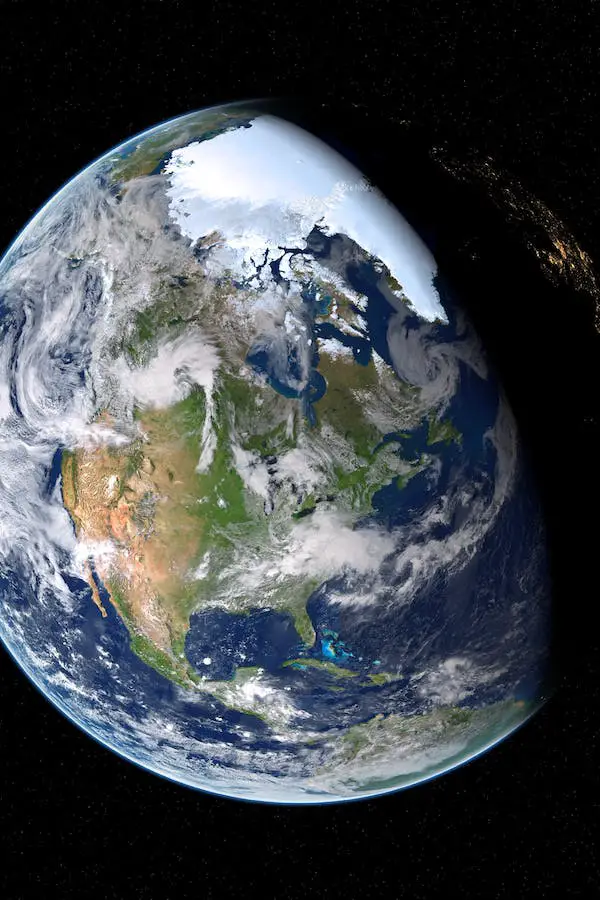
The notion that Columbus was the only one of his time who thought the Earth was round is one of the most persistent misconceptions children acquire.
Everyone else, they believed, thought it was flat. “How courageous must those 1492 sailors have been to sail off towards the edge of the world without fear of falling off!” you might think.
As it turns out, there were plenty of others who thought the Earth was a globe before Columbus was even born.
Read also: What would the world be like If the earth had two moons?
Who discovered the earth is round?
Most people think that the idea that the Earth is round didn’t gain much traction until after Aristotle proposed it around 350 BCE.
But that’s not the case. In fact, the Greek philosopher Pythagoras was the first to come up with the concept of a spherical Earth back in the 6th century BCE.
Pythagoras’s idea was based on his observations of the moon during a lunar eclipse.
He noticed that the shadow cast by the Earth on the moon was always round, no matter what part of the planet was facing the moon.
This was one of the first pieces of evidence that people had that the Earth might be a sphere.
But it wasn’t until about 200 years later that another Greek scholar, Eratosthenes, came up with a way to actually measure the circumference of the Earth.
Eratosthenes was the chief librarian at the Library of Alexandria in Egypt.
He knew that at noon on the summer solstice, the sun was directly overhead at the city of Syene (now called Aswan). But he also knew that in Alexandria, about 800 kilometers to the north, the sun was not directly overhead at that same time.
By measuring the angle of the sun at Alexandria, and knowing the distance between the two cities, Eratosthenes was able to calculate that the circumference of the Earth must be about 250,000 stadia. (Astadia was a unit of measurement used by the Greeks.
There is some debate about how long one stadia actually was, but estimates range from 160 to 210 meters. This would put the circumference of the Earth at anywhere from 40,000 to 50,000 kilometers.)
This was an amazingly accurate estimate, considering that Eratosthenes came up with it more than 2,000 years ago! And he didn’t even have access to modern instruments or technology.
So, while Columbus might get credit for “discovering” that the Earth is round, he was certainly not the first person to come up with the idea.
Read also: What Would Happen If The Earth Stop Rotating

How did galileo know the earth was round?
Galileo Galilei is often credited as the man who finally proved that the Earth is round. But, like Pythagoras and Eratosthenes before him, Galileo didn’t actually “discover” that the Earth was a globe.
He just provided more evidence to support the idea.
In 1609, Galileo heard about a new invention called the telescope. He built his own version of the telescope and pointed it at the night sky.
What he saw amazed him. He observed craters on the moon, four moons orbiting Jupiter, and stars that were too faint to be seen with the naked eye.
Galileo’s observations made him realize that the Earth couldn’t be the only celestial body in the universe.
If there were other planets orbiting other stars, then surely the Earth was also orbiting the sun! And if the Earth was in motion, that meant it couldn’t be a perfect sphere.
It must be slightly flattened at the poles.
Galileo’s observations provided strong evidence that the Earth was indeed a sphere. But it wasn’t until centuries later that we finally had definitive proof that the world is round.
Read also: What Would Happen If the Sun Approaches Earth?
What is the real shape of the earth?
The Earth’s true shape is an oblate spheroid, meaning that it bulges at the equator and flattens at the poles.
This shape is a result of the centrifugal force created by the Earth’s rotation, which causes the equatorial bulge.
The Earth’s radius, which is the distance from its center to its surface, is approximately 6,371 km (3,959 mi).
While the Earth appears to be round when viewed from space, it is actually closer to an oblate spheroid.
The Earth’s diameter bulges at the equator due to the centrifugal force created by the Earth’s rotation, while the diameter flattens at the poles.
This oblate spheroid shape is also the basis for geodesy, the science of measuring and monitoring the size and shape of the Earth, including its gravity field, and determining the location of points on the Earth’s surface.

How do scientists measure the shape of the earth?
Scientists measure the shape of the Earth using a combination of techniques and methods, which have evolved over time.
Some of the key methods include:
Shadows
The Earth’s roundness becomes evident through a simple yet profound observation of shadows.
If our planet were flat, shadows would maintain a consistent length, regardless of location.
However, this is not the case.
By scrutinizing shadows at different locations, the Earth’s curvature is unveiled.
The varying lengths of shadows provide a visual cue that our world is indeed spherical.
Measurement of the Earth’s circumference
In ancient times, the Greek philosopher Eratosthenes devised a brilliant method to measure the Earth’s circumference.
He noticed that the angle of the sun’s rays differed at two locations, allowing him to calculate the Earth’s size.
By comparing the shadows cast by a vertical column at two different places, Eratosthenes made a groundbreaking calculation that confirmed the Earth’s round shape.
Measurement of the Earth’s diameter
Building on Eratosthenes’ work, scientists determined that the Earth’s diameter could be calculated using its circumference and the known relationship between diameter and radius in a circle.
Modern measurements of the Earth’s circumference, often facilitated by orbiting spacecraft, contribute to accurate diameter calculations, offering a comprehensive understanding of our planet’s dimensions.
Triangulation
In the 1800s, Friedrich Georg Wilhelm Struve undertook the Struve Geodetic Arc survey, an ambitious endeavor spanning from Fuglenæs in Norway to Staro-Nekrasovka in Estonia.
Using triangulation, a method involving the creation of long chains of triangles, Struve meticulously measured the Earth’s shape and size.
This groundbreaking survey marked the first accurate measurement of a substantial portion of the Earth’s meridian.
Satellite data
In our contemporary era, scientists leverage space-based satellite systems, including NAVSTAR Global Positioning System (GPS) satellites.
These satellites enable precise measurements, allowing scientists to monitor changes in the Earth’s surface down to the centimeter level.
Satellite data provides valuable insights into the dynamic nature of our planet, contributing to ongoing research and a deeper understanding of Earth’s geophysical features.
The takeaway
It’s interesting to note that, even though the idea of a spherical Earth has been around for thousands of years, it was only in the last couple hundred years that we finally had definitive proof that the world is round.
And it took even longer for everyone to accept the fact!
Today, we take for granted that the Earth is a globe.
But it’s important to remember that this wasn’t always the case.
Pythagoras, Eratosthenes, Galileo, and many other scientists and scholars helped to gradually convince people that the Earth is round.
And their efforts have had a lasting impact on our understanding of the world we live in.
As you can see, there is still much debate on how galileo knew the earth was round.
While many people give him credit, there is still much to learn about his discovery.




